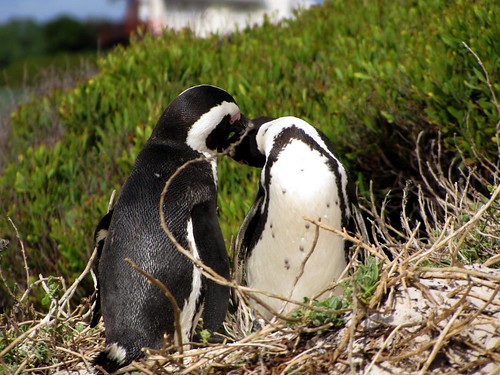
Image courtesy: Catherine Murray
Hello, blogoverse, it's been a while. Have I been madly typing 50 K words for Nanowrimo? I wish! No, I've been playing nursemaid to Little Bear. For the past sixteen days. She's all better from her pneumonia, thank goodness, but I've missed my writing time something fierce.
One of the big news stories to hit during my forced hiatus was the Toronto Zoo Gay Penguin Controversy. As a former zookeeper in charge of eighteen African penguins (in the early 90s), I gotta put my two cents in.
At first, I came firmly down on the zookeeper's side of things. The males in question should be separated and given a chance to bond with the females and propagate. The species needs them!
Then again, if the male pair is 'happy', shouldn't they be left alone?
While I do support gay rights (for humans), I don't think the gay community should be looking to these animals as poster-penguins for their cause. The zoo environment is not natural. It is a radically reduced population and these penguins are highly social animals--a situation that leads to some strange bedfellows (or nest fellows).
Same sex pairs are not the most shocking thing that can and does happen. Once penguins have matured, the idea of 'family' goes out the window. While I was a keeper, we had a grandmother/grandson couple. Did they mate? Yes. Why weren't they split up? The female was old, her eggs were never fertile, and her genes (and thus, her grandson's) were well represented in the population. So this odd couple was left alone.
I've blogged before about the lonely, male penguin who tried to mate with me. (Read here.) When I went back to school, I worked part-time and gave up being head penguin keeper. I would often check in on my beau from the public viewing area. It broke my heart to see him sitting by the door, waiting for me. Happily, he bonded with a young female penguin months later.
We did have a 'gay' couple. The older male's female mate left him for another guy and the younger male hadn't paired with any penguin at that point. So what made them a gay couple? When a male and female are courting, they start by facing each other, rubbing their heads up and down their partner's neck, and braying loudly. They sound like donkeys, which is why these birds are sometimes called "Jackass Penguins". Then they'll flap their wings at each other's bellies which looks like a cross between dancing and hugging. Eventually the male will circle behind the female and, well, you know.
In the male/male version, things start the same way, but both males circle and continue circling like a pair of punch-drunk boxers. That's where it ends, which is why, perhaps, the Toronto Zoo claims the relationship between their male pair is social, not sexual.
At our zoo, the public never knew about any of these bizarre pairings. But if they did, I don't think anyone would protest the separation of our 'gay' couple, because these two were father and son.
So, should the needs of a species trump the 'happiness' of individuals? Zookeeping is not a glamorous job. For me, 90% of my time was spent cleaning up poop while wearing poop-colored clothes speckled with (what else?) poop. When I quit to become a graduate student, my salary went up. Show me a zookeeper and I show you a person who loves animals more than themselves.
In that regard, I think the decision should be left to the zoo. What do you think?



















































